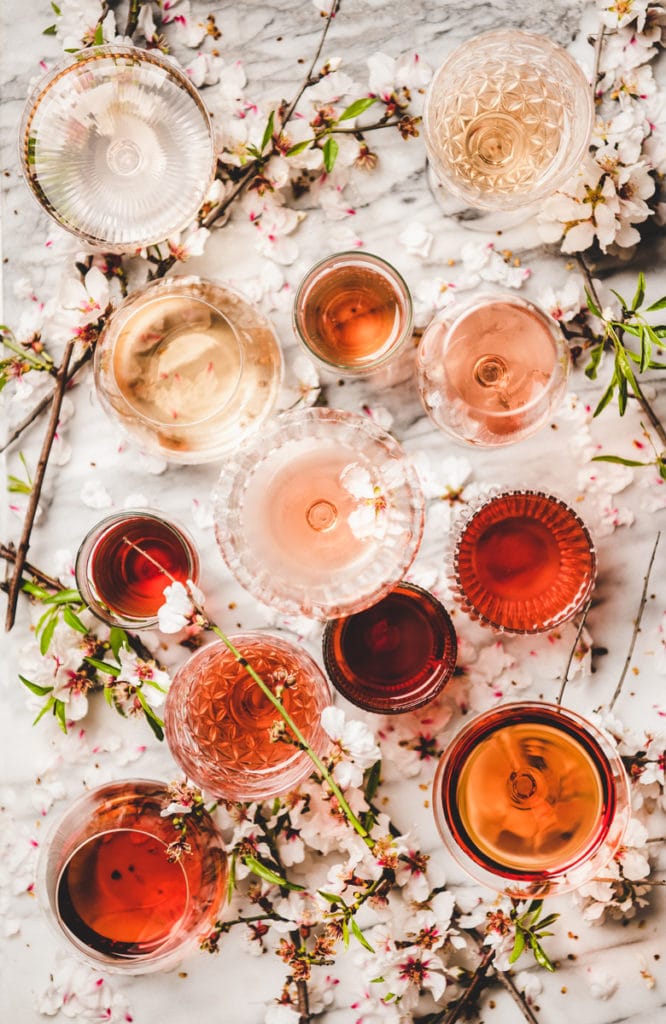
Wine Culture Magazine

Creative Market/Foxys photo
When it comes to summer, there are few things more visually appealing than a glistening glass of pink wine on a sunny day.
Be they the palest shade of onion skin or a deep, gleaming ruby, rosé wines are quintessential patio décor. But can you tell how good a wine will be based on its hue? When it comes to colour, it seems everyone has a preference—and an opinion—on what the most refreshing of rosés should look like.
“With rosé, it’s a hierarchy of traits,” says Howard Soon, winemaker for Vanessa Vineyard in the Similkameen Valley. “I think colour has to come first. We are taught when we taste wine to first look at its colour and clarity. How a wine looks can affect our quality judgement.” However, he continues, “We recognize that colour does not always tell us if the wine is going to smell or taste great.”
The colour of the rosé and the method of achieving it are determined by the winemaker. Colour comes from the grape skins, which means red grapes are used in almost all cases. While there are several ways to achieve this, it basically comes down to this: once grapes are pressed, the skin begins to stain the juice; the longer the grape skins are in contact with their juice, the deeper the shade.
So, in the palest of versions, the skins will be left in contact for mere hours, just enough to add a delicate blush to the juice. A ruby-hued rosé, on the other hand, may have the skins bathing for a couple of days before being separated.
An exception to this rule is the simple blending of red wine and white, such as in Champagne where a small amount of Pinot Noir can be added to achieve the desired pink of sparkling rosé.
Soon’s rosés have been getting progressively paler in recent years and his 2019 version is the fairest yet; he prefers France’s Provençal styles, those with very little extraction of tannins and colour. His goal is to achieve a silky and fruit-driven wine that closely resembles a white.
Soon is not the only one with that predilection. Provence’s pale pinks have taken the world by storm. Even in the neighbouring Rhône Valley, the traditionally ruby-stained rosés have been getting paler.
Tavel, the Southern Rhône’s rosé-only appellation, has long been known for its intensely hued versions with impressive power—wines that are also able to age because of their structure, which is not a trait one considers in the lighter styles. The laws governing the production of Tavel’s wines mandate a minimum level of colour, but in recent years it seems even those nearly-red versions have paled.
Yet not everyone embraces the watery interpretations that are currently so popular.
Kelly McAuliff, an American sommelier and staunch Rhône Valley wine ambassador who resides in Avignon, has strong feelings about what he calls “stained whites.” McAuliff challenges this trend, appealing to winemakers to remain true to the colourful adaptations of his adopted region. “You need to stay with your creator—be the enigma. It’s better to be cerebral, than a fashion,” he says. “This trend of light rosé is not normal; the more colour, the more flavour you get.”
Wendy Vallaster, the founder and former head professor of the Ocea Mae European Sommelier Institute, agrees. She has a fondness for ruby-hued rosés from her years living in Spain.
The additional time with the skins adds more complexity to the wine, giving more depth and making it very food friendly.
“Spanish rosado is a staple year-round. It tends to be darker in colour from those of Provence,” she says. “The additional time with the skins adds more complexity to the wine, giving more depth and making it very food friendly. Rosado works great with pork, turkey, charcuterie; it’s an amazing salmon pairing, or summer salads.”
What’s equally fascinating about rosé wines is how we’ve seen them evolve over the past decade. Initially, many equated those pale versions with sweet Californian blush wines, and darker versions were thought to be modern and drier. What consumers discovered was there were zero certainties: light could be dry and dark could be sweet. We needed to know the maker and the estate style, a fact that remains true today.
Even so, Provence’s fame has compelled us with its drier and luminous but faded interpretations, a genre that seems to have ravenous admirers and many producers have taken note.
The good news is that every winemaking country from New Zealand to Chile and Canada to Croatia makes variations of pink wine, be they still or sparkling, so there are plenty of options for all rosé enthusiasts.
Mirabeau X, Coteaux d’Aix en Provence 2018
(Provence, $25.99) Blushing pink, charming and pristine.
Stoneleigh Wild Valley Rosé 2018
(Marlborough, New Zealand, $20) Rusty red, tangy, notable tannic structure.
Bodegas Garzón Estate Pinot Noir Rosé 2019
(Uruguay, $16.50) Berries and violets, dry, juicy, structured.
Jean-Luc Colombo Cape Bleue Rosé 2018
(Méditerranée, $20) Fresh and floral, pristine and postured.
SpearHead Pinot Noir Rosé
(Kelowna, $22) Strawberries and peaches silky, expressive and vibrant.
Moet & Chandon Rosé Imperial NV
(Champagne France, $83) Tangy, buttery, toasted and creamy.

Daenna Van Mulligen is a sommelier, educator, keynote speaker and radio host who launched WineDiva.ca 15 years ago, and WineScores.ca soon after. She is also a regular contributor to TASTE, Vines and Montecristo magazines.

Daenna Van Mulligen is a sommelier, educator, keynote speaker and radio host who launched WineDiva.ca 15 years ago, and WineScores.ca soon after. She is also a regular contributor to TASTE, Vines and Montecristo magazines.
@ Vitis Magazine